„Biker“-Jacket: zippered pockets (part 1)
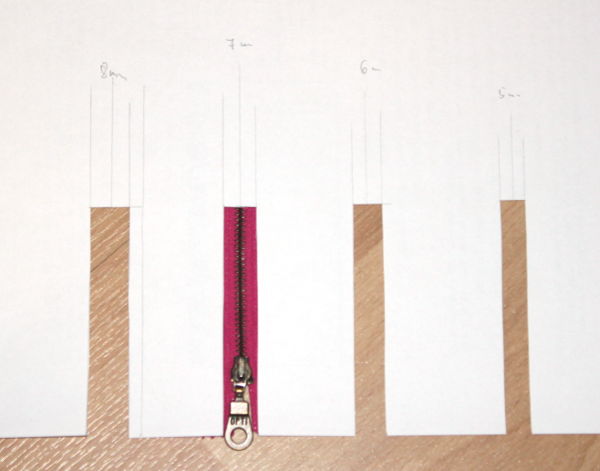 Auch die Taschen brauchen Belege und Reißverschlüsse. Bevor ich damit losgelegt habe (das heißt, auch schon bevor ich mit den Ärmelschlitzen angefangen habe) mußte ich aber erst mal rausfinden, wie breit der Ausschnitt überhaupt sein soll. Dazu haben ich einfach Schablonen in verschiedenen Breiten in in Blatt Papier geschnitten, den Reißverschluß drunter gelegt und geguckt, was mir gefällt und wo genug Platz bleibt, um das Reißverschlußband auch noch festzunähen.
Auch die Taschen brauchen Belege und Reißverschlüsse. Bevor ich damit losgelegt habe (das heißt, auch schon bevor ich mit den Ärmelschlitzen angefangen habe) mußte ich aber erst mal rausfinden, wie breit der Ausschnitt überhaupt sein soll. Dazu haben ich einfach Schablonen in verschiedenen Breiten in in Blatt Papier geschnitten, den Reißverschluß drunter gelegt und geguckt, was mir gefällt und wo genug Platz bleibt, um das Reißverschlußband auch noch festzunähen.
My front pockets need facings and a zipper, too. But before I could start (actually before I could start making the sleeve vents) I had to decide, how wide I wanted the opening for the zipper to be. I simply cut gauges in a sheet of paper in different widths and checked how wide I liked the view and if there would be enough zipper band left to sew it down.
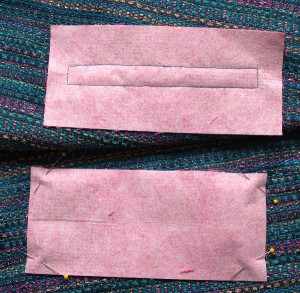 Für die Belege habe ich meinen Kontraststoff mit fester (H200) Vlieseline verstärkt und dann Rechtecke ausgeschnitten. Eigentlich sollten sie rundum 4cm breiter sein als der Schlitz, da ich aber mal wieder zu doof war, mir meine Zahlen auch richtig zu merken waren es dann in der Länge nur je 2cm. Reicht auch. Der Beleg wird jeweils rechts auf rechts auf den Tascheneingriff gesteckt und dann wird ein Rechteck genäht. (Vorzeichnen mit einem Lineal ist praktisch…)
Für die Belege habe ich meinen Kontraststoff mit fester (H200) Vlieseline verstärkt und dann Rechtecke ausgeschnitten. Eigentlich sollten sie rundum 4cm breiter sein als der Schlitz, da ich aber mal wieder zu doof war, mir meine Zahlen auch richtig zu merken waren es dann in der Länge nur je 2cm. Reicht auch. Der Beleg wird jeweils rechts auf rechts auf den Tascheneingriff gesteckt und dann wird ein Rechteck genäht. (Vorzeichnen mit einem Lineal ist praktisch…)
For the zipper facing I interfaced my contrast fabric with rather stiff interfacing (Vlieseline H200) and cut rectangles. They were meant to be 4cm larger then the opening. But I was too stupid to remember my numbers correctly, so the are only 2cm longer on top and bottom. Will do. Then I pinned the facings right sides together over my jacket fronts and stitched a rectangle in the shape of the zipper opening. (Drawing the lines with a ruler beforehand is useful…)
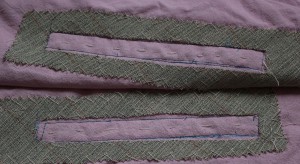 Auf der linken Stoffseite kontrollieren, daß die Nahtlinie innerhalb der Öffnung der Einlage liegt. Wenn nicht, einzelne Fädchen der Einlage rausfriemeln. Mehr als ein Gewebefaden sollte es aber nicht sein, sonst noch mal trennen.
Auf der linken Stoffseite kontrollieren, daß die Nahtlinie innerhalb der Öffnung der Einlage liegt. Wenn nicht, einzelne Fädchen der Einlage rausfriemeln. Mehr als ein Gewebefaden sollte es aber nicht sein, sonst noch mal trennen.
Checking on the left side of the fabric if the seam lines are inside the opening in the horsehair interfacing. If not removing some stray fibers from the interfacing. It should not be more than one thread width. Otherwise ripping the seam out.
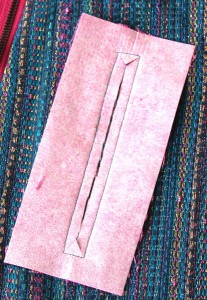 Danach kommt das gleiche Spielchen wie beim Ärmelschlitz: zuerst eine eingefädelte Nadel bereitlegen, dann die Tasche aufschneiden (hier durch alle Stofflagen) und den Oberstoff sofort von Hand versäubern.
Danach kommt das gleiche Spielchen wie beim Ärmelschlitz: zuerst eine eingefädelte Nadel bereitlegen, dann die Tasche aufschneiden (hier durch alle Stofflagen) und den Oberstoff sofort von Hand versäubern.
Then the same thing as on the sleeve vents: Preparing a threaded needle, then cutting the opening (through all layers of fabric) and immediately overcasting the cut edges of the fraying fabric by hand.
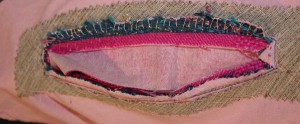 Bei den eher dicken und teilweise sperrigen Stoffen ist es wichtig, die Nahtzugabe erst einmal auseinanderzubügeln. Dadurch entsteht ein schöner Bruch, um den sich der Stoff später quasi von selber legt.
Bei den eher dicken und teilweise sperrigen Stoffen ist es wichtig, die Nahtzugabe erst einmal auseinanderzubügeln. Dadurch entsteht ein schöner Bruch, um den sich der Stoff später quasi von selber legt.
With my relatively thick and partially not very „compliant“ fabrics it is essential first to press the seam allowances to both sides. So the seam itself creates a natural foldline and will fold later much easier.
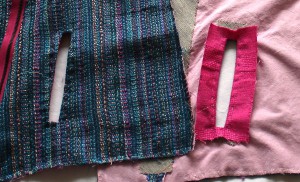 Anschließend wird der Beleg auf die linke Seite gezogen, dort zuerst an der Kante festgeheftet und dann noch mal gut gebügelt. Das Ergebnis ist ein rechteckiger Ausschnitt.
Anschließend wird der Beleg auf die linke Seite gezogen, dort zuerst an der Kante festgeheftet und dann noch mal gut gebügelt. Das Ergebnis ist ein rechteckiger Ausschnitt.
Afterwards you pull the facing through to the left side of the front pieces. Then basting the foldline and again pressing well. The result is a rectangular opening.
Wie daraus eine Tasche wird… schreibe ich demnächst. 🙂
How that becomes a pocket…. I’ll describe soon. 🙂
